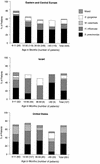Prevalence of antimicrobial-resistant pathogens in middle ear fluid: multinational study of 917 children with acute otitis media
- PMID: 9517937
- PMCID: PMC105503
- DOI: 10.1128/AAC.42.3.589
Prevalence of antimicrobial-resistant pathogens in middle ear fluid: multinational study of 917 children with acute otitis media
Abstract
The management of acute otitis media is complicated by the emergence of resistance to beta-lactam and other antibiotics among common pathogens. We conducted a large, international study of infants and children with acute otitis media to identify pathogens and susceptibility patterns. During the winter of 1994 to 1995, middle ear fluid samples were collected from 917 patients with acute otitis media in Bulgaria, the Czech Republic, Hungary, Romania, Slovakia, Israel, and the United States. A single reference laboratory performed in vitro susceptibility testing. Pathogens were isolated from 62% of the patients. For Streptococcus pneumoniae (30% of the patients), untypeable Haemophilus influenzae (17%), and Moraxella catarrhalis (4%), there was significant variation among geographic regions (P < 0.001). The composite susceptibilities of these three organisms to amoxicillin ranged from 62% in the United States to 89% in Eastern and Central Europe; the corresponding susceptibilities to amoxicillin-clavulanate ranged from 90% in Israel to 95% in Eastern and Central Europe. beta-Lactamase was produced by 31 and 100% of the isolates of H. influenzae and M. catarrhalis, respectively. More isolates of S. pneumoniae were susceptible to amoxicillin (90%) or amoxicillin-clavulanate (90%) than to penicillin (70%; P = 0.002). The prevalence of resistant S. pneumoniae was highest in patients less than 12 months of age. S. pneumoniae, H. influenzae, and M. catarrhalis remain the most important bacterial pathogens in patients with acute otitis media; however, their prevalence is variable and resistance patterns are changing.
Figures



References
-
- Appelbaum, P. C. 1994. Antibiotic-resistant pneumococci—facts and fiction. J. Chemother. 6(Suppl. 4):7–15. - PubMed
-
- Appelbaum P C. Antimicrobial resistance in Streptococcus pneumoniae: an overview. Clin Infect Dis. 1992;15:77–83. - PubMed
-
- Appelbaum P C, Bhamjee A, Scragg J N, Hallett A F, Bowen A J, Cooper R C. Streptococcus pneumoniae resistant to penicillin and chloramphenicol. Lancet. 1977;ii:995–997. - PubMed
-
- Appelbaum P C, Gladkova C, Hryniewicz W, Kojouharov B, Kotulova D, Mihalcu F, Schindler J, Setchanova L, Semina N, Trupl J, Tyski S, Urbaskova P, Jacobs M R. Carriage of antibiotic-resistant Streptococcus pneumoniae by children in Eastern and Central Europe—a multicenter study with use of standardized methods. Clin Infect Dis. 1996;23:712–717. - PubMed
-
- Berman S. Otitis media in children. N Engl J Med. 1995;332:1560–1565. - PubMed
Publication types
MeSH terms
Substances
LinkOut - more resources
Full Text Sources
Other Literature Sources

